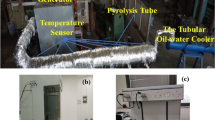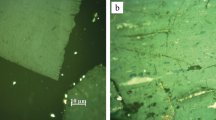Abstract
Coal and gas outbursts are related to the pore structure of coal, in order to study the pore characteristics of high-temperature coal mine and the impact of invasive water on its development, the invasive water treatment and water bath process at the high temperature of coal samples taken from Yangliu Mine, Guqiao Mine, and Dingji Mine were carried out. The pore characteristics of the raw coal (R-coal) samples and invasive water coal (IW-coal) samples were analyzed through the mercury intrusion porosimetry (MIP) and CO2 gas adsorption testing. The results show that the pore connectivity in macropore phase is significantly better than that in mesopore stage. And the porosity, total pore volume, total surface area, and micropore ratio increase with the increase of R-coal rank. The mesopore ratio decreases as the R-coal rank increases, and macropore ratio has the trend of “decrease-increase” with the increasing R-coal rank. After the water intrusion into R-coal samples at high temperature, the porosity increases significantly, however, there is no effect on the pore connectivity. The total surface area, micropore ratio, and micropore volume of the coal samples decrease because of the invasive water, leading the adsorbed gas to convert into free gas. The total pore volume, mesopore ratio, and macropore ratio increase, increasing the channel of gas diffusion and permeability. The results provide a theoretical basis for exploring the effect of the invasive water on gas migration in the high-temperature coal mine.







Similar content being viewed by others
References
Andreas R, Erik R, Sergei S, Ernst H, Georg D (2012) Hydraulic fracturing stimulation techniques and formation damage mechanisms-implications from laboratory testing of tight sandstone-proppant systems. Chem Der Erde 70:107–117
Arnold J, Clauser C, Pechnig R, Anferova S, Anferov V, Blümich B (2006) Porosity and permeability from mobile NMR core-scanning. Petrophysics 47:306–318
China General Administration of Quality Supervision (2008) Method of determining microscopically the reflectance of vitrinite in coal. Beijing
China State Administration of Work Safety (2009) MT/T 1087-2008 Test methods for proximate analysis of coal by instruments. Beijing
China State Administration of Work Safety (2010) Method of preparing coal samples for the coal petrographic analysis. Beijing
China State Bureau of Quality Technology Supervision (1998) Determination of maceral group composition and minerals coal China standard press. Beijing
Gauler C (1971) Studying vugular rocks by constant-rate mercury injection. SPE J 3612:1–13
George JD, Barakat MA (2001) The change in effective stress associated with shrinkage from gas desorption in coal. Int J Coal Geol 45:105–113
Hiroyuki S, Sumihiko M, Tsuyoshi I (2011) The distinct element analysis for hydraulic fracturing in hard rock considering fluid viscosity and particle size distribution. Int J Rock Mech Min Sci 48:712–727
ISO (2005) ISO11760:2005, Classification of coals.
Liu YK, Zhou FB, Liu L, Liu C, Hu SY (2011) An experimental and numerical investigation on the deformation of overlying coal seams above double-seam extraction for controlling coal mine methane emissions. Int J Coal Geol 87:139–149
Liu CJ, Sang SX, Zhang K, Song F, Wang HW, Fan XF (2019) Effects of temperature and pressure on pore morphology of different rank coals: implications for CO2 geological storage. J CO2 Utili 34:343–352
Lu SQ, Zhang YL, Sa ZY, Si SF, Shu LY, Wang L (2019a) Damage-induced permeability model of coal and its application to gas pre-drainage in combination of soft coal and hard coal. Ener Sci Enginee 7:1352–1367
Lu SQ, Zhang YL, Sa ZY, Si SF (2019b) Evaluation of the effect of adsorbed gas and free gas on mechanical properties of coal. Environ Earth Sci 78:218
Natalia H (2016) Temperature induced development of porous structure of bituminous coal chars at high pressure. J Susta Mini 15:120–126
Ni GH, Dong K, Li S, Sun Q (2019a) Gas desorption characteristics effected by the pulsating hydraulic fracturing in coal. Fuel 236:190–200
Ni GH, Li Z, Sun Q, Li S, Dong K (2019b) Effects of [Bmim][Cl] ionic liquid with different concentrations on the functional groups and wettability of coal. Advan Powder Techn 30:610–624
Ni GH, Xie HC, Li S, Sun Q, Huang DM, Cheng YY, Wang N (2019c) The effect of anionic surfactant (SDS) on pore-fracture evolution of acidified coal and its significance for coalbed methane extraction. Advan Powder Techn 30:940–951
Rodrigues CF, Lemos MJ (2002) The measurement of coal porosity with different gases. Int J Coal Geol 48:245–253
Satya H, Richard AS (1990) Shrinkage of coal matrix with release of gas and its impact on permeability of coal. Fuel 69:551–556
Tang ZQ, Zhai C, Zou QL, Qin L (2016) Changes to coal pores and fracture development by ultrasonic wave excitation using nuclear magnetic resonance. Fuel 186:571–578
The State Administration of quality supervision, inspection and Quarantine of China, the National Standardization Management Committee of China (2008) GB474-2008 method for the preparation of coal samples. Beijing
Wang GX, We XR, Wang K, Massarotto P, Rudolph V (2010) Sorption-induced swelling/shrinkage and permeability of coal under stressed adsorption/desorption conditions. Int J Coal Geol 83:46–54
Wang HF, Cheng YP, Yuan L (2013) Gas outburst disasters and the mining technology of key protective seam in coal seam group in the Huainan coalfield. Nat Hazards 67:763–782
Wang G, Chu X, Yang X (2016) Numerical simulation of gas flow in artificial fracture coal by three-dimensional reconstruction based on computed tomography. J Nat Gas Sci Engin 34:823–831
Wang G, Li W, Wang P (2017) Deformation and gas flow characteristics of coal-like materials under triaxial stress conditions. Int J Rock Mech Min Sci 91:72–80
Westphal H, Surholt I, Kiesl C, Thern HF, Kruspe T (2005) NMR measurement in carbonate rocks: problems and an approach to solution. Pure Appl Geophys 16:549–556
Xie JN, Ni GH, Xie HC, Li S, Sun Q, Dong K (2019a) The effect of adding surfactant to the treating acid on the chemical properties of an acid-treated coal. Powder Technol 356:263–272
Xie HC, Ni GH, Li S, Sun Q, Dong K, Xie JN, Wang G, Liu YX (2019b) The influence of surfactant on pore fractal characteristics of composite acidized coal. Fuel 253:741–753
Yao YB, Liu DM, Tang DZ, Tang SH, Huang WH (2008) Fractal characterization of adsorption-pores of coals from North China: an investigation on CH4 adsorption capacity of coals. Int J Coal Geol 73:27–42
Yao YB, Liu DM, Yao C (2010) Petrophysical characterization of coals by low-field nuclear magnetic resonance (NMR). Fuel 89:1371–1380
Yu YM, Liang WG, Hu YQ, Meng QR (2012) Study of micro-pores development in lean coal with temperature. Int J Rock Mech Min Sci 51:91–96
Zhai C, Qin L, Liu SM, Xu JZ (2016) Pore structure in coal: pore evolution after cryogenic freezing with cyclic liquid nitrogen injection and its implication on coalbed methane extraction. Energy Fuel 30:6009–6020
Funding
This work was financially supported by the National Key Research and Development Program of China (2017YFC0805201), the National Natural Science Foundation of China (Nos. 51704186 and 51704179), the key research and development Plan of Shandong Province, China (No. 2018GSF116010), the China Postdoctoral Science Foundation (2017 M622235 and 2019 T120599), the Shandong Province Postdoctoral Innovation Project (201703025), and the Qingdao Postdoctoral Researcher Applied Research Project.
Author information
Authors and Affiliations
Corresponding authors
Additional information
Responsible Editor: Murat Karakus
Rights and permissions
About this article
Cite this article
Jingna, X., Guanhua, N., Jian, H. et al. The pore characteristics of high temperature coal mine and the impact of invasive water on its development. Arab J Geosci 12, 657 (2019). https://doi.org/10.1007/s12517-019-4856-4
Received:
Accepted:
Published:
DOI: https://doi.org/10.1007/s12517-019-4856-4




